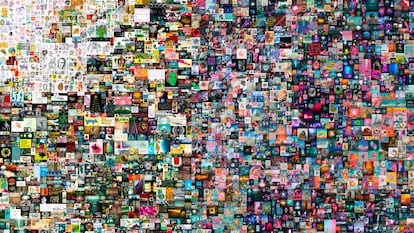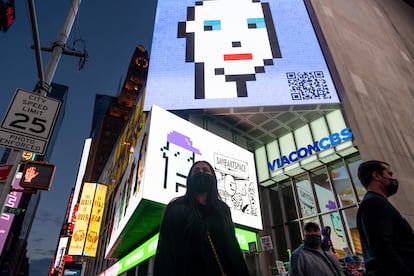Euphoria in digital art: A bubble or an NFT revolution?
Recent high-profile sales of artworks presented as non-fungible tokens offer the promise of fast money. But experts warn that speculation and ignorance are fueling increasingly risky bets

On March 11 of this year, one of the most important auctions in recent years took place at Christie’s – in complete silence. There was no heated bidding, and nothing went under a noisy hammer, but large sums were still changing hands: the artist known as Beeple sold his work “First 5000 Days” for $69.3 million.
“It was the third highest price ever achieved by a living artist,” said Beatriz Ordovás, director of the postwar and contemporary art department at Christie’s Spain. This sale was a milestone not so much for the price, but for being the first time a major auction house had offered a purely digital work of art that would be paid for in cryptocurrency and auctioned online. The authenticity of Beeple’s work was guaranteed by a non-fungible token (NFT), a unique digital certificate that is linked to a file.
In a world where everything can be replicated with a simple copy-and-paste, NFTs lend uniqueness to an image, and endow it with exclusivity. “They function as a guarantee of authenticity,” Ordovás explained. Beeple’s work, a huge collage made up of 5,000 images made over the same number of days, may have artistic value, but it is the NFT associated with it that gives it economic value. Some see these assets as a revolution that will change the art world forever, while others denounce what they see as a bubble that will burst and leave nothing but a trail of smoke.
Before making history at Christie’s, the average value of a Beeple work hovered around $100. “Digital artists couldn’t sell their art like those working in the physical world. NFTs have ended that discrimination,” explained Primavera De Filippi, a researcher at Harvard University’s Berkman-Klein Center for Internet & Society and the French National Center for Scientific Research. De Filippi has an optimistic view of the technology, and believes that it has enhanced the work of artists such as Beeple by replicating the limitations of the physical world to drive up prices: “NFTs have artificially created a form of digital scarcity and this enhances the value of a work,” she said. NFTs have introduced new artists to the art market, she believes, and also introduced new buyers.

The value of the digital art market grew by 299% last year, according to the NFT 2020 Report, and that is just the tip of the iceberg: the luxury market, video games, music and sports teams also want a piece. The first tweet by Twitter’s Jack Dorsey was sold in the form of an NFT for almost $3 million in March. A few days later, the Nyan Cat meme (a cat with a rainbow trail) reached $600,000. Singer The Weeknd sold a collection of music and videos last April for $2 million in the form of an NFT. Ozuna, Steve Aoki and other musicians have also jumped onto the bandwagon. St. Petersburg’s Hermitage Museum will photograph its works and tokenize them, selling off images that are in the public domain for thousands of dollars. Virtually any asset could be sold for an astronomical amount.
These NFTs are not bought with legal tender, but with cryptocurrencies, usually Ethereum, the currency of the Ethereum blockchain. Blockchain technology guarantees the veracity of transactions over the internet, and because of Ethereum’s central role in NFTs’ growth, its value has climbed more than 1,700% since the beginning of 2020. Many believe this growth is not organic.
“There is clearly speculation,” said Andrés Guadamuz, a professor at the University of Sussex and expert in digital intellectual property rights. “Many of us who have been watching this world have been caught by surprise by this fad,” he added, placing the tipping point at the beginning of this year and the sale of Beeple’s NFT.
The ever higher prices, however, are now starting to signs of an overheated market. Activity associated with NFTs has varied greatly across all trackable metrics. The number of people using NFT markets fell 80% from a peak of 650,000 at the beginning of the year to about 128,000 the first week of August. Sales volume was verging on an impressive $200 million last February, but interest dropped sharply in subsequent months, sitting at just $25 million in May, according to the Statista website. Some saw this as the death throes of NFTs, while others believed they only proved their extreme volatility. The market has ended up proving the latter opinion correct, as in August NFT sales set a new record ($206 million).
What happens next is anyone’s guess. “Ethereum is a very unstable cryptocurrency,” Guadamuz pointed out, “and as such the astronomical prices we are talking about are, to some extent, illusory.” The see-sawing prices of Ethereum and its lack of real-world uses pushes investors to make risky bets, which are increasingly disconnected from physical reality, like playing poker with Monopoly money. “This is very real,” disagreed the researcher Primavera De Filippi. “You can’t make a purchase with Ethereum, but you can exchange it for legal tender whenever you want. It’s like saying gold is a fictional asset because you can’t go buy bread with gold bullion.”

Speculation has been a part of collecting art long before NFTs came along. But the newness and unfamiliarity of the technology makes it much riskier. “Trading in new and relatively unknown instruments, such as NFTs, is not so much a form of investment as a bet,” said Jo Michell, Associate Professor of Economics at UWE Bristol. The gamble is risky because market trends are not driven by relatively predictable behavior such as a company going bust or the progressive career of an artist. “A lot of the action is driven by herd-chasing,” Michell added. But in the crypto-art herd, not all cattle are created equal. “The very wealthy are willing to spend lump sums of money on status tokens, such as NFTs,” said the economist. “This leads to other more humble investors imitating them.”
Another reason for crypto-art fever is less often considered: psychology. The emotional attachment we have to certain items, and the social status we imbue them with, affects our understanding of their value. Collecting is based on this process, from stamp collecting to the tulip mania bubble of 17th-century Holland, when tulip bulbs were sometimes traded for mansions, in the wildest example of how collecting can generate economic distortion.
Matt Stephenson is a PhD candidate at Columbia University and researches behavioral economics and NFTs from a psychological perspective. “People are excited about them because they have certain properties of the real-world objects that we’re used to,” he explained. “They are unique, can be owned, sold, destroyed and tracked over time. As a result, if an artist creates NFT art, it has the same properties as a traditional painting.
”The fact that people will pay millions for a NFT but not for a JPG file, which is also used to save digital images, says more about us than it does about the art market, Stephenson believes. “Cognitive psychology suggests that humans can distinguish between virtually identical objects based on an intricate set of socially accepted interests, beliefs and intentions,” he said. Value, therefore, has a strong social component.
In early May, Kyle Swenson’s Twitter feed started filling up with monkeys: monkeys in sunglasses, monkeys in Hawaiian shirts, monkeys in sailor hats, with frozen smiles and funny faces. It was all a little weird, Swenson thought, until the 25-year-old Florida salesman bought his own monkey avatar. He had joined the Bored Ape Yacht Club, a website selling NFT-linked avatars. The site launched on April 30 and put 10,000 images of primates up for sale. Each avatar, with a cartoon aesthetic and unique characteristics, went on the market for around $200. They disappeared within a day. Most users bought several to resell or exchange them. Today they can only be purchased second-hand on the Open Sea platform, and the cheapest one goes for about $45,000. While the rarest apes reach astronomical figures, more common specimens are more readily available. In a way, they are like baseball cards, only with a lot more money at stake.
Swenson has two Bored Apes, two Bored Ape Kennels, some Goatz, some Pudgy Penguins, some Alien Boys... These are all part of different NFT collections. Just as there were once soccer and Disney movie stickers at a newsstand, there are NFT collections of all kinds on the internet. The Bored Apes are the latest to catch on. The first, and most successful, were the CryptoPunks. One of these eight-bit images sold at Christie’s last May for nearly $17 million.
Avant-garde art?
So why do people pay such exorbitant amounts? “From an artistic point of view, I would say they are a piece of crap,” stated Guadamuz bluntly. “But the value of the CryptoPunks is that they were the first.” De Filippi agrees with him, while recognizing their simplicity and tracing an avant-garde lineage. “It’s like [Marcel] Duchamp, who was the first to create ready-made works [everyday objects that were transformed into art only through their context]. That’s why his works have value, for being pioneering.”
The first rule of Bored Ape Yacht Club is simple: monkey see, monkey do. “Before I joined I barely had any followers on Twitter, now I have a couple thousand,” Swenson proudly confessed. The social component of NFT communities is important to collectors, as gaining status and making noise about your collectibles can drive up the price. Essentially, what makes you cooler sometimes makes you richer, too.
There are no yachts or monkeys, but the Bored Ape Yacht Club really functions as a social club. “When you buy a primate you join a community,” explained Swenson, who also founded the Bored Ape Gazette, the newspaper of record for this community. Stephenson confirmed that there is a large component of social psychology in the rise of these collectibles. “There’s definitely a fun, even childlike, feel to collecting NFTs,” he said. “And showing them to your friends, collecting the rare ones...is definitely part of the appeal.”
This expert believes that the success of NFT collectibles depends on what is now known as the attention economy. Stephenson’s own profile picture on Twitter is a monkey with a funny face, which means it’s easy to recognize him as one of the 10,000 avatars of the Bored Ape Yacht Club. It was a gift: “That’s why he has a birthday hat.” Stephenson, like many others, has joined the party. And it’s one that seems far from over.
Tu suscripción se está usando en otro dispositivo
¿Quieres añadir otro usuario a tu suscripción?
Si continúas leyendo en este dispositivo, no se podrá leer en el otro.
FlechaTu suscripción se está usando en otro dispositivo y solo puedes acceder a EL PAÍS desde un dispositivo a la vez.
Si quieres compartir tu cuenta, cambia tu suscripción a la modalidad Premium, así podrás añadir otro usuario. Cada uno accederá con su propia cuenta de email, lo que os permitirá personalizar vuestra experiencia en EL PAÍS.
¿Tienes una suscripción de empresa? Accede aquí para contratar más cuentas.
En el caso de no saber quién está usando tu cuenta, te recomendamos cambiar tu contraseña aquí.
Si decides continuar compartiendo tu cuenta, este mensaje se mostrará en tu dispositivo y en el de la otra persona que está usando tu cuenta de forma indefinida, afectando a tu experiencia de lectura. Puedes consultar aquí los términos y condiciones de la suscripción digital.
More information
Archived In
Últimas noticias
Most viewed
- Sinaloa Cartel war is taking its toll on Los Chapitos
- Reinhard Genzel, Nobel laureate in physics: ‘One-minute videos will never give you the truth’
- Oona Chaplin: ‘I told James Cameron that I was living in a treehouse and starting a permaculture project with a friend’
- Why the price of coffee has skyrocketed: from Brazilian plantations to specialty coffee houses
- David King, chemist: ‘There are scientists studying how to cool the planet; nobody should stop these experiments from happening’











































